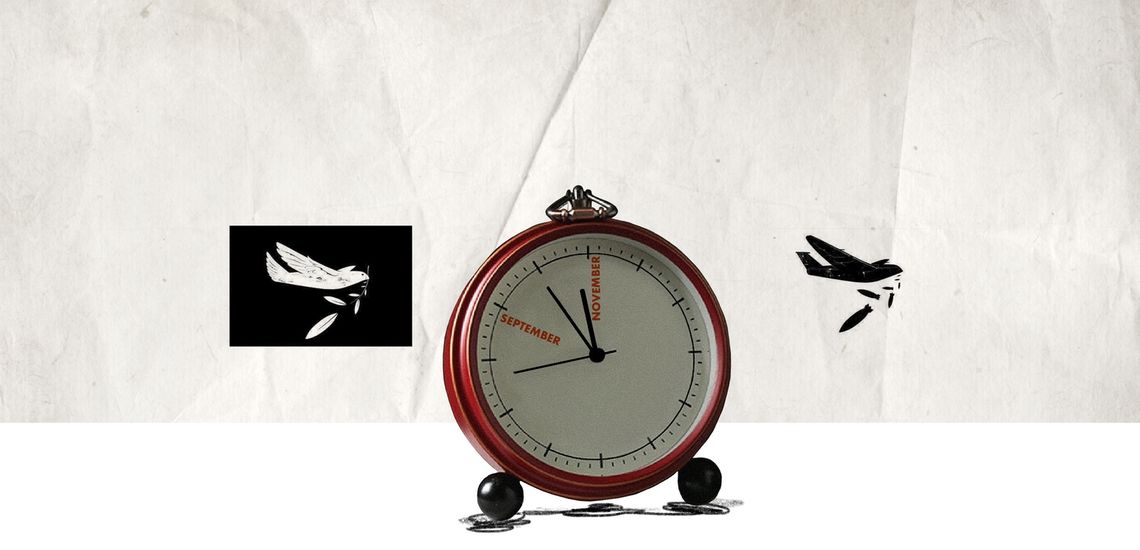A year has passed since the end of the 2020 Artsakh War. The ceasefire statement signed by the leaders of Russia, Armenia and Azerbaijan on November 9, 2020, brought a new geopolitical reality to the region, turning the tables in the Nagorno-Karabakh conflict zone. The devastating defeat in the 44-day war significantly shrank Armenia’s sovereignty and agency, created multiple new security challenges, and plunged the country into political turmoil.
The effects of the 44-day war on Artsakh have understandably been even more disastrous. The Artsakh Republic lost the vast majority of its territory, including multiple towns and villages that were never previously on the table to be conceded to Azerbaijan throughout the previous three decades of peace negotiations. Tens of thousands of people were displaced from their homes as a result of the Azerbaijani aggression. Artsakh lost the lion’s share of its economic resources and became even more dependent on the subsidies provided by the government of Armenia. Most of the territory that has remained under the control of Stepanakert is now a frontline area.
In this new post-war equation, Russia’s peacekeeping mission that was deployed in Artsakh after the signing of the ceasefire statement has become the main guarantor of relative security and stability in the conflict zone. However, the presence of the Russian peacekeeping force has also noticeably decreased Armenia’s influence in Artsakh and also considerably curtailed the sovereignty of the Artsakh authorities. The mere fact that the Russian peacekeeping mission is now de facto in charge of approving the entry permits for foreigners to Artsakh is an important indicator of the Artsakh government’s reduced sovereignty.
In short, the 44-day war and the terms of the November 9 ceasefire statement have had calamitous consequences for Armenia and Artsakh. The new post-war status-quo has put Armenia in an extremely vulnerable position, further increasing its dependence on Russia in security issues. Moreover, in the aftermath of the war, a process of soul-searching began within Armenia, during which various people from all walks of life started to question the ability of the Armenian society to maintain an independent and sovereign state. This is an ongoing situation and can be described as a full-blown statehood crisis.
However, a year after the end of hostilities in Artsakh, it is important to understand not just what happened in the aftermath of the war, but also what did not happen. Armenia and Artsakh have managed to avoid a sequence of developments that would have engendered even more grave consequences for the future of the two republics.
One of the main challenges in the post-war period was the preservation of the constitutional order in Armenia. Countries experiencing national debacles of such scale can easily end up with a total collapse of the state, civil wars and coup d’etats. For instance, during the First Nagorno-Karabakh War, two presidents of Azerbaijan were overthrown by their political opponents after military losses on the battlefield and rebelling field commanders were a political factor to be reckoned with.
Armenia faced similar challenges in the direct aftermath of the war. Hours after the signing of the ceasefire statement, an angry mob attacked the Speaker of the National Assembly, Ararat Mirzoyan, severely beating him. The Government headquarters were also stormed by a violent crowd and taken over. Months after these chaotic events, the top brass of the Armenian Armed Forces issued a statement, demanding the resignation of the Prime Minister.
Nonetheless, to the surprise of many within and outside Armenia, the months-long political crisis in the country was resolved through early parliamentary elections, held on June 20, 2021. Armenian society turned out to be mature enough to settle its internal differences via democratic mechanisms, rejecting violence as a means to settle disputes. This is a significant achievement that has not received enough attention. If a real coup had ever been executed, it would have dragged the country into decades of political stagnation.
After its decisive victory in the 44-day war, Azerbaijan has been trying to close the Karabakh chapter once and for all. Baku tries to advance the narrative that the conflict is over. It has even been denying the existence of Nagorno-Karabakh as an administrative unit and demanding that Russia disarm the Artsakh Defense Army.
However, none of these goals have been achieved by Azerbaijan so far. The OSCE Minsk Group Co-chair countries, Russia, the U.S. and France, issue statements on a regular basis, emphasizing the need for the resumption of comprehensive negotiations. The U.S. and France publicly declare that the final political status of Nagorno-Karabakh still needs to be resolved through talks in the Minsk Group format. Russia also agrees that the status issue is unresolved, but is content to delay the political settlement of the conflict to an indefinite future.
The Republic of Artsakh has been significantly weakened and territorially shrunk, but it is still a properly functioning state, whose authorities were elected by their people. The Artsakh government is de-facto recognized by the command of the Russian peacekeeping mission, and fully controls the unoccupied parts of Artsakh. Despite serious concerns in the early stages of the post-war period, the Artsakh Defense Army hasn’t been disarmed or disbanded. The armed forces are undergoing a process of restructuring and reform, in the meantime continuing to implement their core function. The worst-case scenario was avoided in the aftermath of the war.
Another negative development that seemed imminent right after the war was the gradual disengagement of Armenia from Artsakh. Both the military defeat in the war and the deployment of the Russian peacekeeping force in the conflict zone have considerably reduced Yerevan’s leverage in Artsakh. In the early post-war months, Yerevan’s involvement in Artsakh was limited to the financial support granted by the government of Armenia to Artsakh and its citizens. However, most of the pre-war ties between different government bodies of Armenia and Artsakh were later restored. New formats of cooperation between the two states were also established. Eventually, the process of Armenia’s complete disengagement from Artsakh was reversed.
On the first anniversary of the ceasefire statement that ended the 2020 Artsakh War, Armenia and Artsakh remain in a very vulnerable position. After the collapse of its security architecture, Armenia is less sovereign, independent and self-sufficient than ever. In Artsakh, the only factor preventing the ethnic cleansing of the local population is the presence of the Russian peacekeeping mission. Nonetheless, the situation is not as bad as it could have played out. The Armenian republics have managed to avoid the worst-case scenarios. Aliyev, in his turn, hasn’t succeeded in achieving his maximalist goals of eliminating Armenians from Artsakh.




